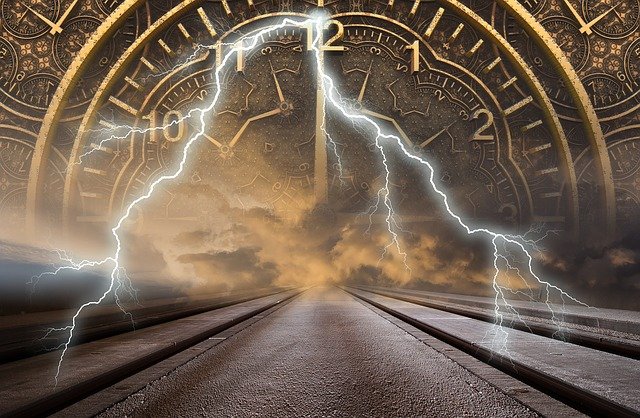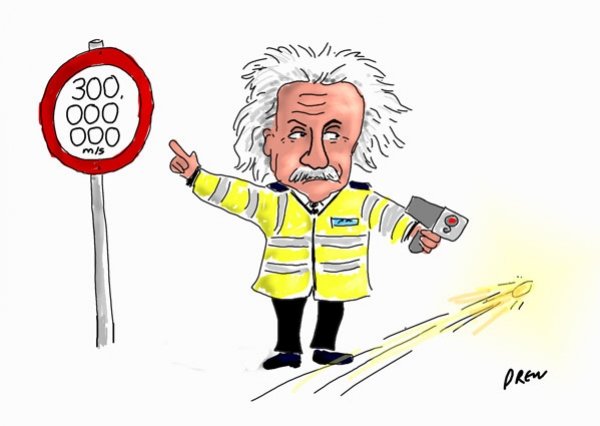The desire to move forward and backward in time is one of the great dreams in human history. Can we build a time travel machine - or whether we've managed?

Image Credit
Recently I watched a video from a film filmed in 1938 at the DuPont factory in Massachusetts, USA. The photograph shows a young woman conducting a lively conversation on a sophisticated phone. This video has aroused great excitement among Internet surfers because it shows, according to its viewers, traveling in time using a new technology that is inconsistent with the time the film was filmed.
The excitement, of course, seems unnecessary. There are many reasons to assume that this is not sufficient evidence of the existence of time travel in our universe if indeed they are being prepared. Suffice it to mention that this conversation, which supposedly takes place on a telephone without wires, leaves no impression on its surroundings and it is reasonable to assume that the woman has a wallet or something else.
We should also say that we are a cell phone generation and we may be inclined to see a smartphone in every object that is close to the ear. This idea is a little reminiscent of the Japanese saying: If all the objects in our world were hammers, everything would look like a nail. What is added to this video is the fact that it is expressed, time after time, in our culture: the sensitivity and the intense and unexplained desire we have for time travel.
The Dream Of Time
But this dream has already gone beyond sensitivity - it's really an obsession. Some of the most prominent features of our culture - the myths, the legends, the literature and the cinema - are loaded with adventures and heroes that are wandering back and forth.What are these journeys that are so exciting to us?
What is this strong urge to travel to the past, or to the future?
These questions become even acuter if we remember that our science and technology are still far from building an efficient system that can move people, or objects, on time, beyond the linear process.
Which means that for the time being, we are all moving into the future at the rate of the clock. Suppose, for example, that tomorrow, in the future world, the football finals will be held in the Champions League, we will reach this world of tomorrow only in 24 hours. this is what there is.
But imagine we could have reached the end of the game a long time ago - let's say already in the next few minutes!
The exciting possibilities of such jumps and abbreviations of time are not only economic
(the fact that we can fill out a Powerball form with the winning numbers), but much more.

Image Credit
Imagine that we could have a glimpse of the world that there would be another hundred, or a thousand years? And what about a good jump towards? How exciting would it be if we could look at some of the events that shaped our civilization? Wander through Mesopotamia with the guards who develop the cuneiform? Perhaps to walk in Agora - the city square in ancient Athens during the time of Socrates and Plato? And what about a small expedition to South America in the past to follow the beginnings of Mayan civilization? And it is impossible to end these imaginary leapfrogs without skipping several tens of millions of years and landing somewhere in the Cretaceous period to finally understand what happened to the dinosaurs that for millions of years were the dominant beings on the planet.
It is not surprising that we are constantly looking for the ultimate machine that will finally release us from the limitations of time. For centuries and thousands of years, plots have been written in which time was a flexible and elusive dimension and almost devoid of legality. The first to make any order in this matter was H.G.Wells, who wrote in the late 19th century the "The Time Machine" The plot describes a hero who travels to the distant future and returns safely with fascinating stories about the creatures that will be born here in the future world.
Wells' story lays the foundations for the modern science fiction genre, in detail, and in the characterization, it proposes for the time he calls the fourth dimension - about ten years before Einstein speaks of it in his private theory of relativity.
![quote-it-is-impossible-to-imagine-a-four-dimensional-space-i-personally-find-it-hard-enough-stephen-hawking-82-82-90[1].jpg](https://images.hive.blog/768x0/https://steemitimages.com/DQmbtuSfEWmCm4Bk76YdzSKCCW2qLs8eba6t7nqPQgthpRn/quote-it-is-impossible-to-imagine-a-four-dimensional-space-i-personally-find-it-hard-enough-stephen-hawking-82-82-90%5B1%5D.jpg)
Image Credit
Reflections on the nature of time and potential journeys appear in much earlier stories. A particularly fantastic journey is edited by one of the heroes of the Hindu mythology, King Kakudmi, who was perhaps one of the first travelers of the time. In a story written in 700 BC, Kakudmi was a king who ruled a kingdom called Kusasthali and lived under the ocean. The king, who was equipped with mystical powers, knew how to reach Brahma's residence, the Creator, and even exchange words with him. When Kakudmi's beautiful daughter comes to an end, the king decides to consult with Brahma about my future son-in-law.
Look at what the Creator God of the universe says about the relativity of time: time, Brahma explains to the king, moves differently, in different places. While you waited for a meeting with me, 108 generations passed through your world!
Indeed, when the king and his daughter return to the past, they are amazed to discover that the environment and the people have changed completely.

King Kakudmi - Image Credit

A journey of equally similar and colorful time, another time traveler - a young Japanese fisherman named Urashima Tarō between the pages of a Japanese fairy tale from the 8th century AD. During the plot, Taro, with the help of a huge and enchanted water turtle, visits a magnificent palace under the sea. The visit to the palace takes three days, but when Taro returns to his village in the real world he finds to his surprise that 300 years have passed and the remains of the village and the family have long since disappeared.

Urashima Tarō - Image Credit

Why go far? In the Talmud, we can read about the famous time adventure of Honi the Circle Maker. The story appears in several versions, but in essence, it speaks of the same scene in which Honi sees an old man planting a carob tree. His cows, according to the old man, are destined only for future generations, seventy years in the future. Honi sits down and dozes until he awakens, seventy years later, to discover the old man's grandson collecting carobs from the tree.

Models
One does not have to conclude from this that carbons are a certain kind of "fuel" for future travel. In general, what motivates the heroes forward or backward in time is the human will and imagination. Science, or at least scientific theories, enter the literary and cinematic plot only during the 19th and 20th centuries.What do they say? The carob recipe or drowsiness is, in the meantime, the most effective way to travel in time, in this case to the future. Theoretical physics, in its various voices, speaks of several possibilities for time travel. Some of the options include the use of various techniques that are heard, at least in the mind of the innocent observer, as fantastical and esoteric, at best. Either way, the impression is that it is difficult to completely rule out the assumption that somewhere in the future, time machines may be built once that know how to travel to other times, especially to the past.

Image Credit
Dominant and regular expressions that arise time after time in articles and interviews of theoretical physicists dealing with time travel are warping time-space, Tachyon and velocity of Speed of light, elongation of time, paradoxes and of course wormholes.
Wow! It appears that the tendency of scientists to use literary and romantic expressions when describing complex scientific processes for the general public is reaching new heights here in time.
Thus, for example, the image of the wormhole comes from the assumption that simulates the space of time in the universe as an apple, and the voyage of time as the perforated worm through the fruit to get out of the other side, at another point and at another time. This hypothesis is based on the general theory of relativity that determines that the space of time can be constrained by the influence of gravity. If we have a strong enough gravitational force, according to physicists, distant points in this space may come very close to one another. But this is not a trivial matter, they add. A journey of this kind requires a significant and significant distortion of the space of time, and in a unique way, so that some type of loop closure is possible, and thus, a return to an event that has already occurred. Black holes, with their enormous gravitational fields, are used by leading candidates for manipulations of this kind. But if you go down to the practical field for a moment, it seems much more complicated. Stephen Hawking, who has commented on this issue on several occasions in the past, claimed that "wormholes" are so tiny that even single atoms are too large to pass, let alone people or ships.

So Where Are They?
Not missing a spoilsport in this area. One of the most fundamental obstacles in time travel is the paradox of time, which in its classic version discusses the possibility of a person traveling back to the time he was not born to prevent the meeting between his parents and his birth. This is not a simple problem, since if he succeeds, he is not born at all, and then the question is who is the traveler at the time he did it?A few years ago Marius Cohen, today a philosophy doctor at Ben-Gurion University, published an instructive article on these paradoxes in Galileo: Cohen reviews the classic paradoxes of time travel and a series of interesting theoretical solutions, one of which is the trivial solution Another solution is the existence of parallel universes that enable the existence of the paradox, and another, perhaps the strangest, solution is what Dr. Cohen refers to as "the spontaneous avoidance of paradoxes." For example, a person who tries to kill his grandmother out of scientific curiosity will never get back in time, and if that does happen, it will never happen again. , He will be killed in an accident before he can reach her or he will accidentally kill another woman. "
To support the argument that time travel is impractical, Professor Stephen Hawking can be asked again, who argued that if it were possible, we would be overwhelmed by time travelers from the future. In the 1940s, there was a gifted Italian nuclear physicist named Enrico Fermi who asked a similar question in a slightly different context. Fermi once took part in a discussion of the existence of extraterrestrial intelligent life.
The hypothesis then, and even today, was that there was little likelihood of life in the galaxy. Fermi asked simply: So where are they? And in exactly the same context one can ask: Where are the passengers of the future? As with any question, this too has several possible answers. For example, the possibility that time travel will be possible only until the point in which the time machine was invented, or that the amount of energy required for such a journey would be so large that it would be done at a very low dose, and only for special purposes. Or perhaps, Dr. Cohen wrote: "Visitors from the future are here, but every time they are exposed, they repeat the past so that their exposure is prevented ..."

Image Credit
And if the option exists, why not check it? On Saturday, May 7, 2005, a group of MIT students initiated a unique conference. The conference was supposed to serve as a meeting point for time travelers from the distant future. The meeting, the organizers claimed, is one-off and will not be the same again in the future, even for the prosaic reason that time tourists will be able to attend this particular conference, time after time, from any future time period. In the publications, the exact geographic point of the conference hall was noted, since the organizers also took into account the possibility that the esteemed Massachusetts Institute of Technology would not take place when somewhere in the distant future the time machine was invented.
The comparison of time travelers to aliens is interesting. If there are indeed groups of creatures of this kind, then at least for now they are hidden and invisible. Nevertheless, one must admit that this possibility that in our world there are tourist tourists who travel to and fro between different periods in human history, perhaps for research purposes, perhaps just as tourists, is an interesting possibility, even an exciting one.
The event, it seems, was organized hastily, and at least according to the site seems more like a time party. Either way, no one came to the event except the organizers themselves and some friends. Is it because the details of the conference have not been published and may not have been marketed correctly? Or do the time travelers have no time for parties? who knows.
Four years later, in 2009, an attempt was made to convene another conference, this time in Israel. During the unannounced event, a small and dignified group of people gathered in a small apartment in the center of Tel Aviv, including an astronomer and physicist, a senior high-tech manager, a computer scientist and the writer. Our main goal was to establish the first time travel club in the world and to prepare the first (and last) meeting of time travelers in the universe.
The first stage of the evening was discussed through the retroactive establishment of the Club. The club was to be established in Victorian London, somewhere in the mid-19th century. The idea was to plant in all kinds of sites, archives, and libraries the founding of the club as a historical fact. The form and manner of distribution of the conference of time received special attention. We thought that we should try to include details about the conference, including rules of conduct and agenda, in all kinds of public libraries, history books, professional journals, sites, and blogs. There were also those who thought that we should turn to traditional and temporary media such as various monoliths, pyramids, bills, coins and even notes in bottles that would be thrown into the ocean.
With regard to the agenda and the rules of the meeting, the prevailing opinion was that one should maintain complete discretion. All discussions about the journey, technologies, source culture and travel destination will be discreet and will be held only in the conference area. Rules have also formulated that spoke of mutual respect and the need to avoid, as much as possible, the creation of paradoxes and the safety of time travelers, as long as this did not endanger the security of the members of the club.
A particularly fascinating question was: How do you identify a traveler when he arrives at a conference, and in general?
Among the ideas thrown into the air was a suggestion to search Google's search engine for questions about events that had not yet occurred during the investigation. In the same matter, it was also suggested to examine videos and security cameras of the Twin Towers that were made near the terrorist attack, in order to try to identify "tourists" waiting in the area to document the incident. Other ideas spoke of rapid DNA tests that might give an indication of longevity, or health beyond normal, a search for businessmen who made sudden money in a short time, or under unclear circumstances, and so on.
Unfortunately, for some reason or another, the rules of the ceremony, which were meticulously written, including the rules of behavior formulated in the spirit of the famous robotics laws of Asimov, the famous science fiction writer, were not put to the test because the planned meeting did not take place. The hypotheses and theories from the world of theoretical physics about time travel and their practical test in the practical world were too early.
Hello 22nd Century
All the odds show that we, and perhaps many generations in the future, will continue to sail to distant lands in the past and in the future only in the open spaces of the world of literature and imagination. It is a bit unpleasant for creatures who see themselves as the sons of an unusually communicative and curious sex. The impossibility of moving in time, beyond its usual course, means that at least for now, we are stuck with ourselves in our time point in space.
Image Credit
Is that so? The truth is, if you want to be a little careful about the subtleties of time, things are not so bad. We have no problem, for example, in giving a glimpse into the world of the past, even if it is fleeting and incomplete. To perform, for example, time travel to the Moon. All we have to do is ... look at him! The moon we see is the "image" that comes to our eye lens after moving in a distance of about -385 000 kilometers, and that the speed of light, 300,000 miles per second approx. Which means that the beautiful brick we see in the sky is a world of the past, a world that hung in our sky a little over a second ago. This fact becomes more dramatic if you look farther. The sun, for example, is a past star that was 7 minutes ago. In this sense, space telescopes that capture stars and galaxies at distances of thousands and millions of light-years are particularly powerful time machines. These telescopes "take" us into distant past worlds, some of which, perhaps, no longer exists today.
The journey to the future is a bit more complex, and the journey forward, we have already mentioned, is done rhythmically from the hands of the clock. What you can do is try and make the road a little more purposeful. The premise, in this case, is the need to communicate with future cultures and perhaps to tell them something about ourselves in a more clear and orderly way.
This attempt was made in the courtyard of the Eretz Israel Museum in Tel Aviv on December 30, 1999, just before the millennium. A short, somewhat bizarre ceremony was held, attended by a large group of dignitaries, including the mayor. During the event, a small time capsule was planted in the ground, carrying a collection of items reflecting the culture, technology, and way of life of Israel at the end of the 20th century. On the walls of the small marble pyramid built on top of it, three operating instructions were engraved in three languages, indicating that it should be opened another hundred years, in December 2099.
The main goal was to build a kind of modern Noah's ark that would sail it a hundred years ahead into the future, carrying with it information about the culture that existed here in the 20th century.
Of course, unlike the time machines in science fiction literature that have succeeded in going through periods of hundreds and thousands of years in short periods, the Israeli box will be placed on the ground every minute and every hour of the planned period. A frustrating journey, since none of us who read these things, will be here at the end of that journey, and in general, it is also difficult to know whether the capsule itself will survive the hardships of the time. It may be the place to be sorry and play for a moment as if
If I had the virtues of Honi the Circle Maker, I would try to doze off a little and wake up here at the end of the third millennium AD to be present at the finish line.





Until next time, thank you for visiting @nirgf
Feel free to leave a comment below!
Great post. I have to re-steem so I can read it in more detail - when I have more time :)
I'm a visual learner so I recommend this book on relativity: The Manga Guide To Relativity.
If the human race can manage to survive, we'll have the capability to "travel into the future" by simply traveling towards greater gravitational areas, or traveling as close as we can to the speed of light. The movie intersteller illustrates one possibility. That makes me wonder if one day there will be a group that just wants to leave society and come back at a different time. How long will they stay gone? If they stay out too long they run the risk of coming back to nothing. There must have been a species that have mastered that and other secrets of the universe. Where are they?
The concept of infinity is another fascinating philosophical subject. In relation to time, what does that mean? These topics very heavy indeed!
"when I have more time" This is exactly the point here, is not it?
To get such a wonderful response from a genius like you is really a compliment.
Thank you @kryptonaut
I'll accept your genius title. Hopefully that will indicate that you made a grave error.
Best genius-related comic from farside:
as Pablo Picasso once said: everything you can imagine is real
Great post! Very much enjoyed reading.
On your point of seeing the "image" of a distant star millions of years in the past, here is an outlandish thought that came to me (probably high at the time) but nonetheless fun to think about-
Imagine a large planet, or system of some sort, that we see roughly 35 million years in the past. The planet made up of a reflective substance, or the system of reflective particles, that when viewed, shows its reflection (similar to a full moon reflecting the suns rays to us). Now if we could pinpoint something fitting this description and find its reflection of Earth, (35 million years before the reflection, 70 million years in the past) with powerful enough technology, we could actually see and observe dinosaurs in nature!
Of course systems are moving, light is distorted by gravity, obviously talking about zooming in on a speck that we would have infinite odds against finding, but the idea is neat to think about, the fact that if all other things were constant this would be ENTIRELY possible.
Until now, everything sounds possible,
A brilliant idea, go ahead and write your idea in the post.
Send a link that we can also read.
Thank you @sether
Your post reminded me of the [Department of Temporal Investigations](Department of Temporal Investigations) from Star Trek.Well then @nirgf this was far more expansive than anticipated!
Tempus Fugit!
Yes, you are right,
Thanks for your "time" to read my post
Hey, you put in so much work writing it it's the least I can do.
Thanks :)
this post taught me a lot of things that I did not know, thank you
thank you, dear friend,
Every day we learn something new
Wibbly wobbly timey wimey... <3
The Day of the Doctor :)
Thank you very much dear
I am a hardcore Whovian. I've lectured about Doctor Who at ICon before it was cool. :P
מרשים מאוד ניר! אהבתי מחכה לראות מה יבוא בהמשך:))
Thank you very much, dear friend
It's a good thing you've come to visit me
this post is very insightful
Thank you, dear friend,
I hope your journey during reading was enjoyable :)
This post has received a 2.50 % upvote from @buildawhale thanks to: @nirgf. Send at least 1 SBD to @buildawhale with a post link in the memo field for a portion of the next vote.
Steem WitnessTo support our daily curation initiative, please vote on my owner, @themarkymark, as a